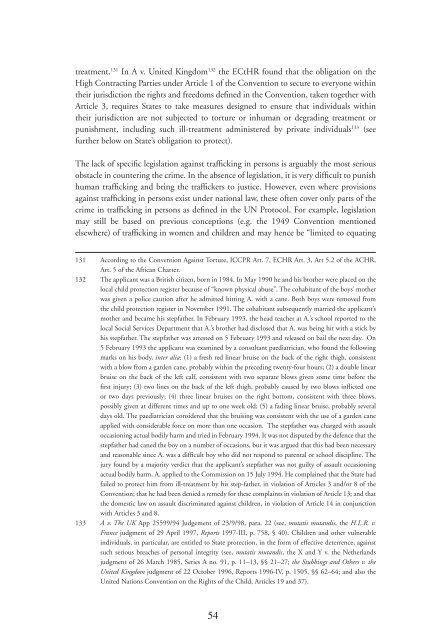Trafficking in human beings: human rights and ... - unesdoc - Unesco
Trafficking in human beings: human rights and ... - unesdoc - Unesco
Trafficking in human beings: human rights and ... - unesdoc - Unesco
You also want an ePaper? Increase the reach of your titles
YUMPU automatically turns print PDFs into web optimized ePapers that Google loves.
treatment. 131 In A v. United K<strong>in</strong>gdom 132 the ECtHR found that the obligation on the<br />
High Contract<strong>in</strong>g Parties under Article 1 of the Convention to secure to everyone with<strong>in</strong><br />
their jurisdiction the <strong>rights</strong> <strong>and</strong> freedoms defi ned <strong>in</strong> the Convention, taken together with<br />
Article 3, requires States to take measures designed to ensure that <strong>in</strong>dividuals with<strong>in</strong><br />
their jurisdiction are not subjected to torture or <strong>in</strong><strong>human</strong> or degrad<strong>in</strong>g treatment or<br />
punishment, <strong>in</strong>clud<strong>in</strong>g such ill-treatment adm<strong>in</strong>istered by private <strong>in</strong>dividuals 133 (see<br />
further below on State’s obligation to protect).<br />
The lack of specifi c legislation aga<strong>in</strong>st traffi ck<strong>in</strong>g <strong>in</strong> persons is arguably the most serious<br />
obstacle <strong>in</strong> counter<strong>in</strong>g the crime. In the absence of legislation, it is very diffi cult to punish<br />
<strong>human</strong> traffi ck<strong>in</strong>g <strong>and</strong> br<strong>in</strong>g the traffi ckers to justice. However, even where provisions<br />
aga<strong>in</strong>st traffi ck<strong>in</strong>g <strong>in</strong> persons exist under national law, these often cover only parts of the<br />
crime <strong>in</strong> traffi ck<strong>in</strong>g <strong>in</strong> persons as defi ned <strong>in</strong> the UN Protocol. For example, legislation<br />
may still be based on previous conceptions (e.g. the 1949 Convention mentioned<br />
elsewhere) of traffi ck<strong>in</strong>g <strong>in</strong> women <strong>and</strong> children <strong>and</strong> may hence be “limited to equat<strong>in</strong>g<br />
131 Accord<strong>in</strong>g to the Convention Aga<strong>in</strong>st Torture, ICCPR Art. 7, ECHR Art. 3, Art 5.2 of the ACHR,<br />
Art. 5 of the African Charter.<br />
132 The applicant was a British citizen, born <strong>in</strong> 1984. In May 1990 he <strong>and</strong> his brother were placed on the<br />
local child protection register because of “known physical abuse”. The cohabitant of the boys’ mother<br />
was given a police caution after he admitted hitt<strong>in</strong>g A. with a cane. Both boys were removed from<br />
the child protection register <strong>in</strong> November 1991. The cohabitant subsequently married the applicant’s<br />
mother <strong>and</strong> became his stepfather. In February 1993, the head teacher at A.’s school reported to the<br />
local Social Services Department that A.’s brother had disclosed that A. was be<strong>in</strong>g hit with a stick by<br />
his stepfather. The stepfather was arrested on 5 February 1993 <strong>and</strong> released on bail the next day. On<br />
5 February 1993 the applicant was exam<strong>in</strong>ed by a consultant paediatrician, who found the follow<strong>in</strong>g<br />
marks on his body, <strong>in</strong>ter alia: (1) a fresh red l<strong>in</strong>ear bruise on the back of the right thigh, consistent<br />
with a blow from a garden cane, probably with<strong>in</strong> the preced<strong>in</strong>g twenty-four hours; (2) a double l<strong>in</strong>ear<br />
bruise on the back of the left calf, consistent with two separate blows given some time before the<br />
fi rst <strong>in</strong>jury; (3) two l<strong>in</strong>es on the back of the left thigh, probably caused by two blows <strong>in</strong>fl icted one<br />
or two days previously; (4) three l<strong>in</strong>ear bruises on the right bottom, consistent with three blows,<br />
possibly given at different times <strong>and</strong> up to one week old; (5) a fad<strong>in</strong>g l<strong>in</strong>ear bruise, probably several<br />
days old. The paediatrician considered that the bruis<strong>in</strong>g was consistent with the use of a garden cane<br />
applied with considerable force on more than one occasion. The stepfather was charged with assault<br />
occasion<strong>in</strong>g actual bodily harm <strong>and</strong> tried <strong>in</strong> February 1994. It was not disputed by the defence that the<br />
stepfather had caned the boy on a number of occasions, but it was argued that this had been necessary<br />
<strong>and</strong> reasonable s<strong>in</strong>ce A. was a diffi cult boy who did not respond to parental or school discipl<strong>in</strong>e. The<br />
jury found by a majority verdict that the applicant’s stepfather was not guilty of assault occasion<strong>in</strong>g<br />
actual bodily harm. A. applied to the Commission on 15 July 1994. He compla<strong>in</strong>ed that the State had<br />
failed to protect him from ill-treatment by his step-father, <strong>in</strong> violation of Articles 3 <strong>and</strong>/or 8 of the<br />
Convention; that he had been denied a remedy for these compla<strong>in</strong>ts <strong>in</strong> violation of Article 13; <strong>and</strong> that<br />
the domestic law on assault discrim<strong>in</strong>ated aga<strong>in</strong>st children, <strong>in</strong> violation of Article 14 <strong>in</strong> conjunction<br />
with Articles 3 <strong>and</strong> 8.<br />
133 A v. The UK App 25599/94 Judgement of 23/9/98, para. 22 (see, mutatis mut<strong>and</strong>is, the H.L.R. v.<br />
France judgment of 29 April 1997, Reports 1997-III, p. 758, § 40). Children <strong>and</strong> other vulnerable<br />
<strong>in</strong>dividuals, <strong>in</strong> particular, are entitled to State protection, <strong>in</strong> the form of effective deterrence, aga<strong>in</strong>st<br />
such serious breaches of personal <strong>in</strong>tegrity (see, mutatis mut<strong>and</strong>is, the X <strong>and</strong> Y v. the Netherl<strong>and</strong>s<br />
judgment of 26 March 1985, Series A no. 91, p. 11–13, §§ 21–27; the Stubb<strong>in</strong>gs <strong>and</strong> Others v. the<br />
United K<strong>in</strong>gdom judgment of 22 October 1996, Reports 1996-IV, p. 1505, §§ 62–64; <strong>and</strong> also the<br />
United Nations Convention on the Rights of the Child, Articles 19 <strong>and</strong> 37).<br />
54

















